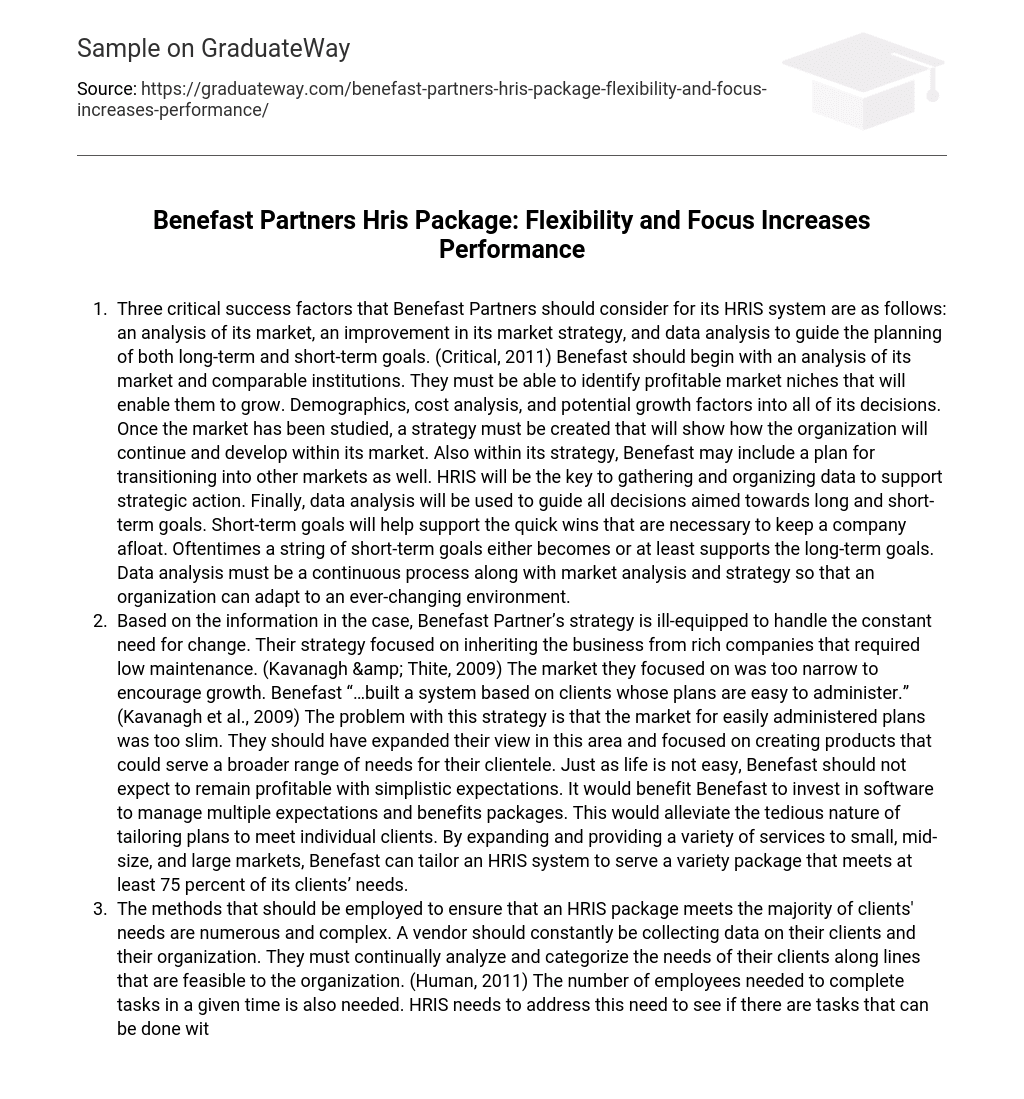- Three critical success factors that Benefast Partners should consider for its HRIS system are as follows: an analysis of its market, an improvement in its market strategy, and data analysis to guide the planning of both long-term and short-term goals. (Critical, 2011) Benefast should begin with an analysis of its market and comparable institutions. They must be able to identify profitable market niches that will enable them to grow. Demographics, cost analysis, and potential growth factors into all of its decisions. Once the market has been studied, a strategy must be created that will show how the organization will continue and develop within its market. Also within its strategy, Benefast may include a plan for transitioning into other markets as well. HRIS will be the key to gathering and organizing data to support strategic action. Finally, data analysis will be used to guide all decisions aimed towards long and short-term goals. Short-term goals will help support the quick wins that are necessary to keep a company afloat. Oftentimes a string of short-term goals either becomes or at least supports the long-term goals. Data analysis must be a continuous process along with market analysis and strategy so that an organization can adapt to an ever-changing environment.
- Based on the information in the case, Benefast Partner’s strategy is ill-equipped to handle the constant need for change. Their strategy focused on inheriting the business from rich companies that required low maintenance. (Kavanagh & Thite, 2009) The market they focused on was too narrow to encourage growth. Benefast “…built a system based on clients whose plans are easy to administer.” (Kavanagh et al., 2009) The problem with this strategy is that the market for easily administered plans was too slim. They should have expanded their view in this area and focused on creating products that could serve a broader range of needs for their clientele. Just as life is not easy, Benefast should not expect to remain profitable with simplistic expectations. It would benefit Benefast to invest in software to manage multiple expectations and benefits packages. This would alleviate the tedious nature of tailoring plans to meet individual clients. By expanding and providing a variety of services to small, mid-size, and large markets, Benefast can tailor an HRIS system to serve a variety package that meets at least 75 percent of its clients’ needs.
- The methods that should be employed to ensure that an HRIS package meets the majority of clients’ needs are numerous and complex. A vendor should constantly be collecting data on their clients and their organization. They must continually analyze and categorize the needs of their clients along lines that are feasible to the organization. (Human, 2011) The number of employees needed to complete tasks in a given time is also needed. HRIS needs to address this need to see if there are tasks that can be done with technology that cut employee time and cost. Coupling this information with the needs analysis of their clients will help HR personnel choose software that can help them serve at least 75 percent of the needs identified previously.
- The role of the HR professional is vital to the success of the human resource information systems company support and customer service. No matter how sophisticated a computer is, it can only do what it is told. The HR professional must decide what data is important and how that data should be used. The HR professional must define the long and short-term goals for its departments and align them with that of the company. Afterward, all factors that directly or indirectly contribute to or negate these goals can also be identified. The HR professional will have to use this information to decide what set of data best represents the factors that affect performance. The data must then be categorized and organized in a view that paints the most complete and accurate representation of the different functions and processes that are modeled by the data. Data can be modeled using tables, charts, and linear regression graphs. HRIS is used to calculate data and make results. The HR is the key component to being able to interpret those results. (Human, 2011) The HR decides what software will be beneficial to the organization so that its goals are met. He/She coordinates efforts between departments and the community. The HR must also analyze the surrounding environment and constantly make adjustments. Finally, the nature of the HR professional leads itself into all aspects of an organization from payroll to future planning. Every step an HR professional employs to increase efficiency saves the company time and money. An effective HRIS saves the HR time and therefore it saves the company money. It frees up time for the HR professional to devote his/her energy to other projects, corporate maintenance, planning, expansion, recruitment, and training. The HR professional is pivotal to the success of a company and any HRIS must serve to support the company’s overall goals.
References
- Critical Success Factor. (2011). Retrieved from http://en.m.wikipedia.org/wiki/Critical_success_factor. Accessed on October 19, 2011. Human Resource Information Systems. (2011). Retrieved from http://www.referenceforbusiness.com/management/Gr-Int/Human-Resource-Information-Systems. html.Accessed on October 20, 2011. Kavanagh, Michael J.; Thite, Mohan (2009). HRIS Needs Analysis. Human Resources Information Systems: Basics, Applications, and Future Decisions. 79-98.





